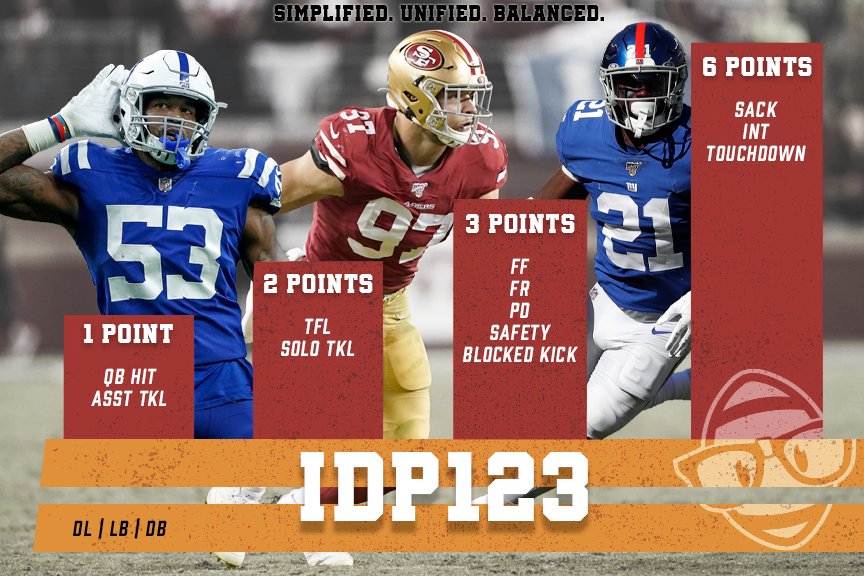
As fantasy football grows in popularity, so do its countless variations. One of the most interesting and entertaining variations to play is IDP. But what is it? And how does it compare to traditional fantasy football? By the time you’ve read this article, you should have the answers to those questions and be ready to start playing in IDP leagues.
What is IDP?
IDP stands for “Individual Defensive Player” and does exactly what it says. Traditional fantasy formats will often see you rostering a team’s defense. In an IDP league, you would instead roster a number of individual defensive players. As with traditional fantasy formats, the exact number of roster spots alloated to the different positions will vary across leagues.
How does IDP scoring work?
One of the reasons that IDP is a less popular fantasy format is the lack of a standarised scoring system. Whilst traditional fantasy football has three common scoring settings – standard, half-PPR, and PPR – there isn’t that sort of consensus with IDP. Whilst this variety helps to cater for a variety of different leagues and playstyles, it can make things a little more daunting for the first-time player.
The most common IDP scoring system is probably ‘IDP123’. This is a simple system that is used as the default scoring system used by apps like Sleeper that accommodate IDP leagues. A summary of the scoring system is provided below.

According to the founder of IDP123, Jordan Rains, “It’s a scoring system that gives defensive players the recognition they deserve for all the actions they’re performing on the field. Not a bland tackle based scoring format. It’s purposefully designed around the mantra IDP, easy as 1,2,3. Most of the points you will score will come in those three values. It’s that easy and that simple.”
Understanding positional definitions
Another important part of playing IDP is understanding how the positional designations work. The vast majority of IDP leagues will put a player into one of three broad categories – defensive line, linebacker, defensive back. Each of these groups obviously contains a number of different positions and playstyles. This means that there is different values within each position that need to be understood.
Take linebacker for example. If you are drafting a linebacker you will have the choice of a traditional inside linebacker like Shaquille Leonard or Roquan Smith. These players tend to rack up a lot of tackles, but not a lot of sacks or TFLs. You will also see players like TJ Watt and Rashan Gary listed as linebackers, though their role is completely different. The same is true of defensive line (edge rushers and defensive tackles) and defensive backs (corners and safeties).
Each of these roles will score points at different rates and that is important to remember. In 2021 for example, there was just one outside linebacker (TJ Watt) who scored 300+ points in IDP123 scoring leagues. In contrast, there were eight inside linebackers who scored 300+ points. Watt was actually the only outside linebacker to rank inside the top 15 in scoring at the linebacker position. Making sure you are taking account of the differences within the positional groups is therefore hugely important.
What positions are most valuable?
As with traditional fantasy football, this depends on the scoring system you use. Just as PPR leagues boost the value of receivers and pass catching running backs, IDP leagues can cater to different positions. That said, for the purpose of this article I will assume that we are talking about a league with an IDP123 scoring system.
In IDP123 leagues, your highest value position is linebacker, and more specifically inside linebacker. Tackles are king in this format and are more stable from game-to-game than big plays like sacks. If you are able to land yourself a linebacker who also gets used as a blitzer (think Micah Parsons or Devin White) then that is even better. The top ten inside linebackers averaged 312.6 points in 2021.
After linebacker you want to look for defensive linemen. They tend to be more frequently involved in plays compared to defensive backs and there are more opportunities for them to score points, with tackles, quarterback hits, TFLs, and sacks. As a general rule edge defenders score more points compared to defensive tackles, but you can still score plenty with the latter if they are productive pass rushers. The top ten defensive linemen averaged 279.3 points in 2021.
Last but not least is defensive backs. Once again, there is a general rule of thumb to work from here. The further the player is from the line of scrimmage, the less valuable. The numbers prove this – in 2021 the top ten defensive backs averaged 249.9 points. This means that your box safeties and slot corners tend to score more than your free safeties and boundary corners. This leads to a situation where the biggest names in real football aren’t necessarily the same in IDP. Jalen Ramsey for instance finished as DB12 last season. Importantly, nine of the 11 players ahead of him were safeties.
How should you value IDP players in startup drafts?
Most of the time when you come across IDP leagues, they will also include offensive players. So how do you value defensive players when doing your startup draft? This can be challenging as most rankings don’t combine offensive and defensive players.
The biggest factor is how many roster spots are allocated to IDP. If you are in a league where you start two or three defenders then they are inherently less valuable. Assuming a 12 team league, you will likely have somewhere in the region of 40 players rostered when factoring in benches. This means that there will be top end talent available at most positions every week on the waiver wire. If you are in a league that is allocating seven, eight, or even more spots to IDP, then it is obviously much more valuable.
You also have to consider scoring format, both for offense and IDP. If, for example, you are playing in a Superflex PPR league you will see the top quarterbacks exceed 350 points per season, as well as a few 300+ point seasons from running backs and wide receivers. If you are using IDP123 scoring, you will also have your top linebackers scoring over 300 points per season, meaning that they are generally of a similar value to the top receivers and running backs.
Defensive linemen are therefore the next tier down from the top skill position players, with the top defensive backs more likely in the WR10-15 range. This isn’t an exact science and will change from season to season, but it is important to remember that in IDP leagues, your defensive stars can be just as important to your roster as the studs on offense.
